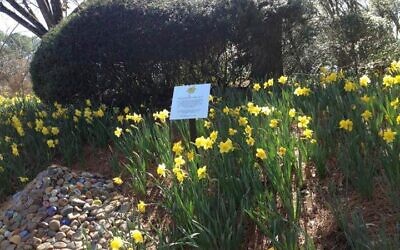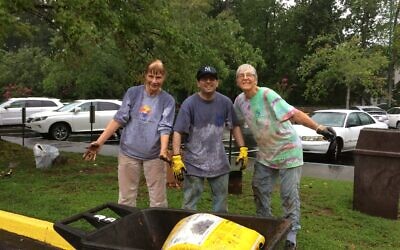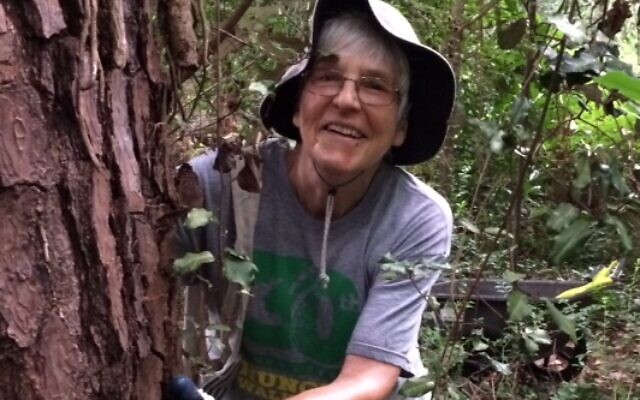Engaging Community by Digging in the Dirt
Volunteers at Ahavath Achim maintain their synagogue garden.
It’s not only landscapers who come to mind when congregants of Congregation Ahavath Achim think of who repairs, maintains and beautifies the gardens of the Buckhead synagogue. It’s a group of synagogue volunteers, including Myrtle Lewin, a white-haired woman with sunglasses, wearing a large-brimmed hat, perhaps donning a T-shirt with a message to plant trees.
After Lewin’s retirement as a mathematics professor at Agnes Scott College in Decatur, this avocational environment activist started gardening initiatives at Ahavath Achim. She chairs AA’s Greening Group along with planning and helping to maintain several areas situated in what the AA website calls “an urban forest setting.”
Lewin tells the AJT that digging in the dirt for her is a form of meditation, where “the four or five hours spent working in the earth with my hands feels more like a few minutes.”
With her own interest in plantings, trees and sustainable gardens, Lewin and many like-minded AA members have been doing this work, and creating community, over the course of more than eight years.
“The first task we worked on was the forest – removing invasives from several hundred trees. English ivy and some poison ivy had totally enveloped many trees.
It was to control the ivy that we got the goats. They ate all the accessible green stuff so that we could get into the area without having to climb over a jungle; this also made it easier to avoid spiders, snakes etc., but the goats do not remove the roots, or kill the plants. That’s why we had to go in by hand when they were done.”

Lewin further explains that these forest area trees “are largely in what we call the ’ravine:’ that huge area on the west of the lower parking lot up the steep hill to the synagogue building. But there are also dozens of trees all along Northside Drive and elsewhere. We are not done. We worked on this intensely for maybe two years.”
In 2013, Lewin and AA volunteers started to restore the grounds on both sides leading to AA’s main entrance. A brown, mostly barren area leading to the main front entrance was transformed to become a perennial garden using large leafy plants and shrubs. The group, according to Lewin, “weeded out tons of overgrown ivy, removed rocks and other debris.” She calls this space the Golden Doors garden, pointing to the large heavy gold metal doors at AA’s main entrance.
The Greening Group landscaped the memorial garden on AA’s west entrance, where six fountains were placed in the pond in front of the Holocaust memorial area naming several of the death camps and concentration camps. The same Greening Group undertook The Daffodil Project of Am Yisrael Chai, which brings families together in late fall to plant daffodil bulbs. Placed at the synagogue’s side entry area, this garden is planted in memory of children who died in the Holocaust.
This past fall, 250 new bulbs were added, so that this garden now contains 2,700 bulbs.
“It’s a wonderful idea. The bulbs regenerate, make babies, … deep messages of survival here.”
Lewin told the AJT that she, along with other AA members, supplement what she calls the “blow, mow and go gardeners,” the professional crew who come weekly to maintain AA’s grounds and gardens.

In addition to her AA garden efforts and being a climate change activist, Lewin has worked with Trees Atlanta for over 20 years by planting trees, which in her words, “is to improve Atlanta’s urban canopy.” Under Lewin’s leadership, there have been eight Tu B’Shevat tree plantings with participation from synagogues, day schools, Hillels and others from across the city. At the most recent Tu B’ Shevat tree planting Feb. 9, about 120 people planted 81 trees.
Lewin hopes that “the broad principles of sustainable gardening used – including maintenance of the tree canopy – will influence others in their practices.”
The inspiration for Lewin’s gardening and environmental work often comes from Jewish text, such as words from Midrash: “Take heed not to damage or destroy My world, for if you damage it, there is no one to make it right after you.” She told the AJT that “It is passages like this that tell me that my sensibilities about the land, and what we can grow, how we need to care for it and protect it, and how the land can yield its fruit, all have deep Jewish roots. This is central to my view of tikkun olam, to repairing the world.”




comments